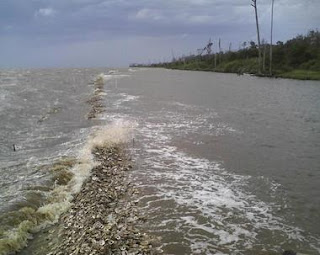Coffee Island, which has been slowly disappearing for decades, has quit shrinking. In fact, there are signs that the island, located just south of Bayou La Batre in the Mississippi Sound, is starting to grow larger. Credit goes to a “living shoreline” experiment dreamt up by the Nature Conservancy and funded by the National Oceanic and Atmospheric Administration. Using a federal stimulus fund grant in 2010, the groups constructed a series of oyster reefs around the southeast side of the island in an effort to combat erosion of the marsh.
As it happened, the Nature Conservancy began dumping 300 dump truck loads worth of oyster shells and 225-pound concrete balls into the water surrounding the island about two weeks before the Deepwater Horizon oil rig exploded and set off the BP oil spill. The goal was to recreate a natural system of oyster reefs that encircled much of Coffee Island long ago, reefs that served to break up waves as they washed ashore.
 |
| Oyster Restoration Reef Protecting Coffee Island Alabama |
As the oil began to drift across the Gulf in 2010, the newly completed, 1.5-mile-long reef on Coffee Island served as the inspiration for the much larger 100/1000 project, which aims to build 100 miles of oyster reefs and 1000 acres of marsh around Mobile Bay. The Press-Register returned to Coffee Island on Thursday morning as a thunderstorm gathered over nearby Grand Bay and a rainbow arced across a darkened sky. It was the newspaper’s first visit since the Nature Conservancy kicked off the project shortly before the oil spill started.
The changes were easy to see.
The oyster shell and concrete reef balls had been placed about 90 feet offshore of the island, an attempt to help restore the shoreline to its position in the year 2000. At the time, the water between the reefs and the shore was nearly three feet deep. Today, it is about shin deep, thanks to a huge amount of sediment trapped behind the reefs. New marsh, primarily spartina grass, is beginning to grow in the sediment, evidence that the island is expanding.
The reefs have about 200 new oysters growing on them per square yard, according to surveys by biologists, a number that rivals or even exceeds natural oyster reefs. A control area on Coffee Island, where no reefs were erected, has no oysters growing in front of it and the marsh continues to recede. But on the new reefs, hermit crabs, stone crabs and oyster drills were abundant, crawling and sliding across the new oysters. Many of those oysters are just months old, growing from natural spat that set in April and May.
Rising up to where they just break the water’s surface at high tide, the reefs have effectively stopped the erosion on Coffee Island, DeQuattro said.“You can stand on the bottom behind the reefs now. It’s firmed up nicely,” he said, drawing a comparison between the soft mud that surrounded the island before the reefs were re-established.
DeQuattro said the project has been much more successful than he expected it to be. That suggests the rest of the 100 miles to be built for the 100/1000 project will have a big impact on Mobile Bay, he said.
“We’re building a reef and it takes time. With oysters, you don’t just dump some shell and, there you go, you have a reef. Creatures have to inhabit the nooks and crannies, crabs and fish. And they’re here. And oysters are growing,” DeQuattro said. “We’ve got all these little clumps of oysters here now. A lot of them are more than year old. We’ve got birds feeding on top of the reefs all the time, or even just hanging out on them. There is so much more life here now.”

No comments:
Post a Comment